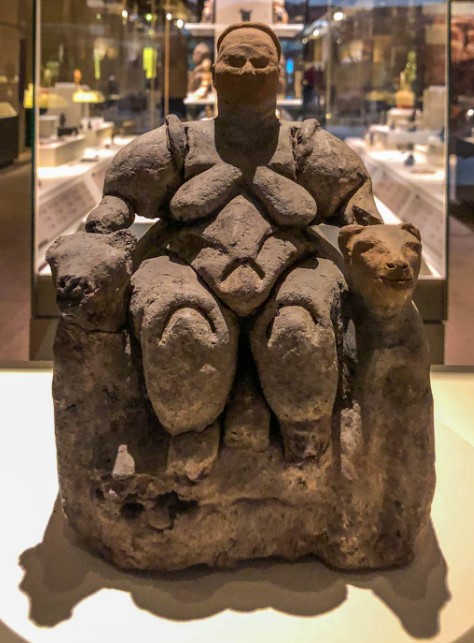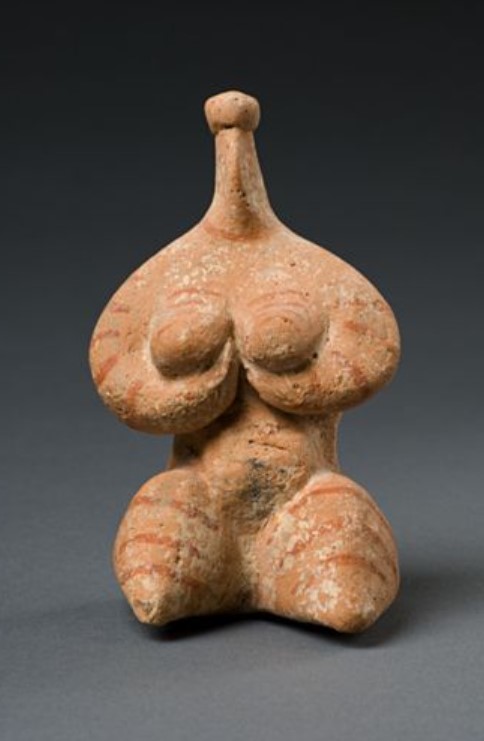Clay Goddess Statuette dating back to around 4800-4100 BC, is an important artifact that provides insight into ancient civilizations. The small but captivating statue stands 19.8 cm tall and originated from the Lower Danube region, possibly modern-day Romania or Bulgaria. Stay tuned to archeology.dulichvn.net to learn more about ancient artifacts.
Historical Significance of the Statuette
The Clay Goddess Statuette holds remarkable importance for historians and archaeologists studying ancient cultures. Its precise origin, spanning the Lower Danube region, speaks to the early cultures of the Neolithic period, providing a connection to a time long before written records.

Early Civilization in the Lower Danube Region
- The Lower Danube region, today encompassing parts of Romania and Bulgaria, was home to several early Neolithic settlements. This figurine reflects the cultural and religious beliefs of these early societies.
- Artifacts from this period shed light on the development of ritualistic practices, with the clay goddess potentially symbolizing fertility or a mother deity.
Significance of the Clay Material
- Clay was a prevalent medium for creating figures in Neolithic societies. Its availability and ease of use allowed for widespread creation of religious or ceremonial figures.
- The use of clay, combined with the detailed craftsmanship of this statuette, highlights the advanced techniques of early potters and sculptors in the region.
See more: Exploring Bannermans Castle 1940 Unique historical heritage of the United States
The Goddess Figure in Ancient Art
- The representation of goddesses in ancient art often relates to fertility, protection, and the cycle of life. This statuette might have held a similar role, acting as a symbolic figure for communities relying on agriculture.
- Goddesses were integral in early spiritual beliefs, often revered in rituals to ensure prosperous harvests or safe childbirth.
The Barbier-Mueller Museum’s Collection
Currently housed in the Barbier-Mueller Museum in Geneva, Switzerland, the Clay Goddess Statuette is part of an extensive collection of artifacts that represent a diverse range of cultures and time periods.

Preserving Ancient Artifacts
- The Barbier-Mueller Museum, renowned for its commitment to preserving ancient cultural treasures, ensures that pieces like this statuette remain available for study and public appreciation.
- By housing such artifacts, the museum helps foster an understanding of the spiritual and artistic practices of early human societies.
Museum’s Role in Cultural Education
- The museum serves as an educational resource for those interested in ancient history and archaeology. It brings together pieces from various civilizations, offering visitors a glimpse into the past.
- The Clay Goddess Statuette is an example of how museums play a vital role in connecting contemporary society to its ancient roots.

Photography and Presentation by Ferrazzini Bouchet
- The stunning image of the statuette was captured by the photo studio Ferrazzini Bouchet, known for its expertise in museum photography. Their work highlights the intricacy and historical importance of such artifacts, ensuring that the statuette’s details are preserved for both scholarly study and public view.
See more: Herstmonceux Castle A Majestic Historical Landmark in East Sussex
A Symbol of Ancient Beliefs
This Clay Goddess Statuette, with its clear, expressive design, invites modern audiences to reflect on the ancient beliefs and practices that shaped early European societies. Through its preservation and exhibition, we are granted a window into a world that lived over 6,000 years ago.

The Role of Goddess Figures in Early Religion
- In early human history, goddess figures like this statuette were often linked to fertility, the earth, and the divine feminine. Their importance could be central to the spiritual practices of the time.
- These figures were not merely decorative but served as important tools for communication between the people and their gods or ancestors.
Influence of the Statuette on Modern Understanding of Ancient Religions
- Studying such artifacts allows historians to reconstruct early religious practices and belief systems. They also highlight the continuity of religious symbols throughout human history, providing a broader understanding of cultural evolution.

Legacy of the Statuette
- As one of the few surviving representations of early goddess figures from the Lower Danube region, this statuette is invaluable to the study of ancient religious and social structures. Its discovery and preservation ensure that its legacy continues to inform modern-day archaeology and history.
Conclusion
The Clay Goddess Statuette is more than just an ancient artifact; it is a bridge connecting the modern world to the spiritual and cultural practices of early civilizations. Its presence in the Barbier-Mueller Museum ensures the preservation of a vital piece of history, offering valuable insights into the beliefs and artistry of the Neolithic communities from the Lower Danube region. This statuette stands as a timeless testament to human creativity and the enduring legacy of ancient faiths, leaving an indelible mark on the story of humanity.

CÁC TIN KHÁC
Mark Twain & Olivia Langdon: A 36-Year Love Story Filled with Laughter and Devotion
The Tollund Man: A 2,400-Year-Old Mystery Preserved in a Danish Bog
Skara Brae: Scotland’s Hidden Neolithic Village
Porta Nigra: The Hidden Depths of Trier’s Iconic Roman Gate